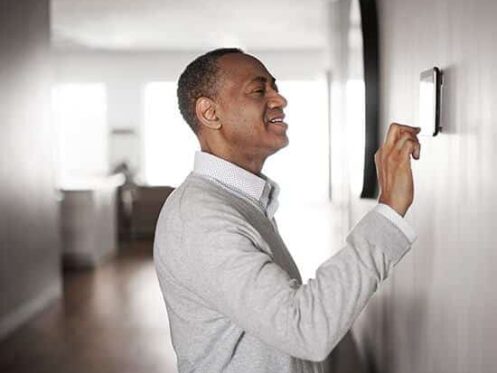Home automation is becoming increasingly popular as more and more people are turning to technology to provide greater control over their houses, appliances, and systems. There is no doubt that home automation systems offer improved convenience. However, they can also make your home safer and more secure and even help to reduce your energy costs. Still, with so many different types of home automation technology available, it is essential that you first think carefully about these questions when considering upgrading your home.
1. What Are Your Primary Goals?
The first thing you’ll want to consider is what your main goals or priorities are. In other words, what are your reasons for wanting a home automation system? Home automation technology can take many different shapes or forms so it is important to think carefully about exactly what you want your system to be able to achieve. For instance, are you mainly concerned with security and being able to monitor your home and lock your doors remotely? Or is your main goal more about the convenience of being able to control your home entertainment system from your phone?
Home automation can be used to control security systems, TVs and stereos, lighting, HVAC systems, etc. However, the type of system and the equipment you need will depend on exactly what functions you want to perform.
2. Is Your Current Equipment Compatible?
The next question is whether the appliances, equipment, or systems you want to be able to control are compatible with home automation. Your home’s heating and air conditioning can also definitely be upgraded with a home automation system simply by installing a smart thermostat. The same is also true for your doors as installing smart locks and door cameras is a simple task.
Most newer smart TVs, stereos, and even ovens can also easily be connected to a home automation system. However, if your equipment or appliances are older, they will most likely need to be upgraded. The same may also be true if your home already has an existing security system that you want to upgrade with smart home technology. This is important to consider as it will affect what you can achieve with the system. Also, needing to replace any appliances or equipment will obviously add to the overall costs.
Most home automation technology relies on your Wi-Fi network to connect with and control the various parts of the system. This means you also need to consider how reliable your connection is and how much bandwidth you have. Each additional component will take up bandwidth as it is constantly in contact with your network.
If your Wi-Fi connection isn’t fast enough, your new home automation system could interfere with your ability for streaming and gaming. Similarly, if your network isn’t reliable and you often have outages, this will interfere with your ability to control your system at all times. For these reasons, it is also essential that you consider whether your Wi-Fi network is up to the task before installing any home automation system.
If you use a voice assistant like Siri, Alexa, or Google Home, you will also need to take this into consideration. Not all home automation systems are compatible with voice control. This means you will need to make sure that whatever system and equipment you opt for is compatible if you want to use voice control on your phone or your hub.
3. How Much Work Will It Take to Install the System?
Another important consideration is the actual installation process. Virtually any home can be upgraded and retrofitted to include home automation technology, but this could require minor or more major work. Installing things like smart lighting, home entertainment controls, video doorbells, and smart thermostats is rather simple as they can use your existing wiring and fixtures.
If you’re looking to upgrade to a video security system, you will likely need to have new wires run for each camera. Some other home automation systems can be plugged directly into an outlet. However, there are often situations where no suitable outlets are available where the components need to be. In this situation, you may need to have an electrician install additional outlets.
You may also need to have new electrical circuits installed or existing circuits may need to be split up or combined. In some cases, you may even need to replace your main electrical panel or add a sub-panel if there isn’t enough space to accommodate the new circuits. All of these factors are important considerations since they will affect how difficult the system is to install and thus how much everything will cost.
4. How Much Will the Whole System Cost?
The previous point ties directly into this one. Unless you are on an unlimited budget, you will want to think carefully about how much everything will cost and how much you’re willing to spend. This is important as it will help you get a more realistic idea of what your home automation system will and won’t be able to do.
It can also help you choose between various options that may be able to achieve the same goals. For instance, smart light bulbs, smart light switches, and smart outlets are all available and can be used to control lamps and hard-wired light fixtures. While each of these can be used for a similar function, they will vary in terms of purchase price and ease of installation.
5. How Will You Connect to and Control the System?
Another issue to consider is how you want to connect to and control the system. Some home automation systems are controlled remotely via an app on your phone whereas other systems rely on a central control panel inside the home. Similarly, some equipment can only be controlled using a proprietary app while others can be connected to a central hub so that all of your home automation technology can be controlled from the same app.
As we already said, most home automation systems are connected via Wi-Fi. However, some systems can also be connected to a central hub via some other protocol like Bluetooth or Zigbee. This is an important consideration as using a different protocol will ensure that the system doesn’t put as big of a strain on your Wi-Fi network. That being said, there may also be drawbacks to not using Wi-Fi, which is why this is another thing to think carefully about.
Northern California’s Home Automation Experts
If you’re considering upgrading your house with a home automation system, Environmental Heating & Air Solutions is the one to trust. We have been serving residents of Roseville and other areas of Northern California since 2010, and our team has the experience to take care of all of your home automation needs. We install a wide range of home automation systems and equipment, and we can help ensure that your specific goals are met.
If you’re not sure where to start, we offer a convenient home automation starter package. This includes a Nest HELLO video doorbell, Ecobee smart thermostat, and Nest Protect carbon monoxide and smoke alarm. Our team also provides heating, cooling, indoor air quality, and plumbing services. If you’re looking to upgrade with home automation technology, contact us today for a free, no-obligation quote.

